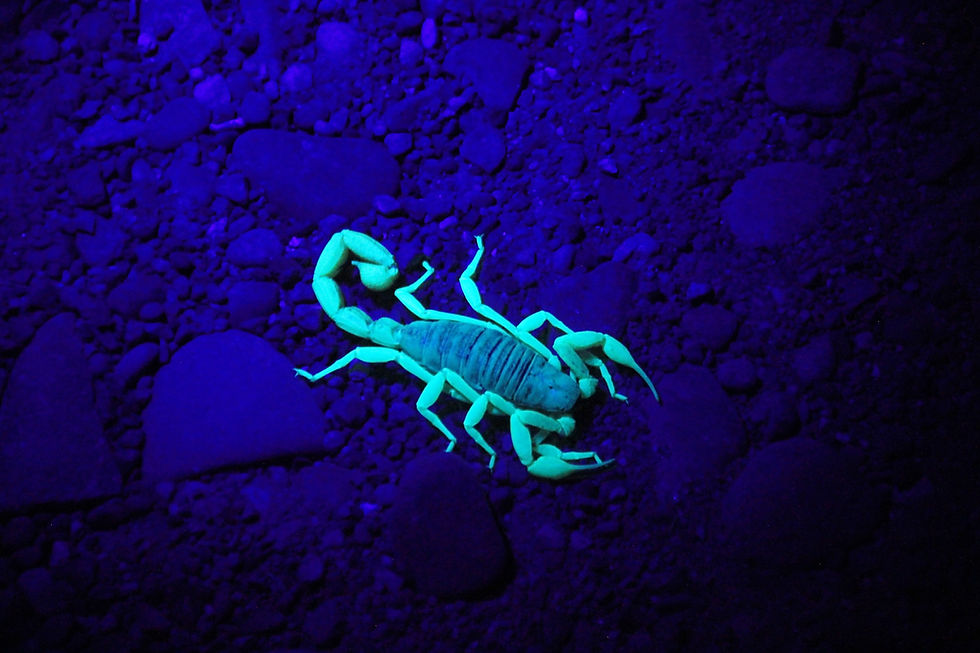Serket - Scorpion Goddess of Egypt
- Sylvia Rose

- Jun 11, 2024
- 4 min read
Serket is the ancient Egyptian goddess of healing relating to venomous stings of scorpions and bites of snakes. She often wears a scorpion on her head as her symbol. Her siblings are crocodile god Sobek and chaos snake Apep.
READ: Cult of the Fire God - Bronze Age Quest Adventure
Scorpions are fluorescent. Scientists are not sure why but do know the ability comes from the exoskeleton. Scorpions have an outer layer or cuticle, part of the exoskeleton.
READ: Cult of the Fire God - Bronze Age Quest Adventure
This cuticle has a thin layer, the hyaline layer. As this reacts to ultraviolet (UV) black light or even moonlight the scorpion’s body begins to glow. It doesn't happen immediately but is gradually noticeable.
Serket is initially the deification of the scorpion. Her mother Neith is an early ancient Egyptian goddess. Egyptian creation myths vary. In one version Neith creates the universe and all within it, and influences its activity.
READ: Lora Ley Adventures - Germanic Mythology Fiction Series
Neith is the goddess of the cosmos, fate, wisdom, water, rivers, mothers, childbirth, hunting, weaving and war. In her warrior aspect she's often named as an Eye of Ra goddess. Her recorded history goes back to the 4th millennium BCE.
The father of Serket is Khnum, an ancient creator god also c. 4th millennium BCE, who manifests as a ram-headed potter. On his potter's wheel he makes the great cosmic egg containing the Sun. He creates people and the other animals from clay.
READ: Lora Ley Adventures - Germanic Mythology Fiction Series
Serket's name means "she who tightens the throat" or "she who causes the throat to breath". She has associations with justice as she's thought to sting those who do evil. She cures snakebite and scorpion sting.
She may appear fully as a scorpion in early Egyptian art. She can also be depicted as a woman-headed scorpion, or a woman with a scorpion on her head. Worshipped at several centers she has few temples, but many priests.
It's not uncommon for gods to share temples with related deities. A healing goddess against scorpion venom and snakebite, Serket also protects the deities from Apep and may guard the Snake of Chaos when he's captured,
Due to prominence of the deathstalker and other species, as well a number of venomous snakes such as cobras and vipers, Serket is worshiped as patron goddess of several pharaohs. Pharaoh or peasant, a person must live a good life to gain her blessing.
READ: Reiker For Hire - Victorian Detective Murder Mysteries
Some scorpion stings can cause paralysis and death. Toxicity and effects vary by species and condition of patient. Children 6 years and younger are more likely to have harmful effects from venomous scorpions.
Venom of the giant scorpion causes paralysis in its prey. The sting is not as serious to humans. The venom is distilled into medicines against various kinds of microorganisms. In Vietnam H. laoticus is farmed as food. It's also used to make snake wine (scorpion wine).
Symptoms of or reactions to a scorpion sting can include:
Intense immediate pain lasting from minutes to 24 hours.
Swelling, itching, and a change in skin color.
Nausea and vomiting.
Anxiety, drowsiness, fainting.
Increased saliva, tears, and sweat.
Numbness of the tongue.
Vision problems.
Trouble breathing.
Two Pharaohs are named for her directly. Scorpion I reigns in the late 4th century BCE. Scorpion II, possibly Selk or Weha, also called King Scorpion, is a ruler during the Protodynastic Period of Upper Egypt (c. 3200 - 3000 BCE).
READ: Reiker For Hire - Victorian Detective Murder Mysteries
Serket is also protector of the dead, especially associated with venoms and fluids having a stiffening effect. She watches over the tents of embalmers. She's also guardian of the canopic jar associated with venom, or the jar of the intestine.
Canopic jars are used by the ancient Egyptians during mummification to store and preserve the viscera of the deceased for the afterlife. Earliest canopic jars are made of stone. Laster styles appear in wood or ceramic.
Ritual use of the jars goes back to the Old Kingdom (c. 2649 - 2130 BCE). By the Late Period or the Ptolemaic Period (c. 305 - 30 BCE) they fall out of use as the viscera are wrapped and placed with the body.
Associated with the canopic jars Serket forms a connection to Neith, Isis, and Nephthys, who have similar roles. As time goes by, Serket is identified with Isis, sharing imagery and parentage as Serket-Isis. Eventually, Serket comes to be an aspect of Isis.











